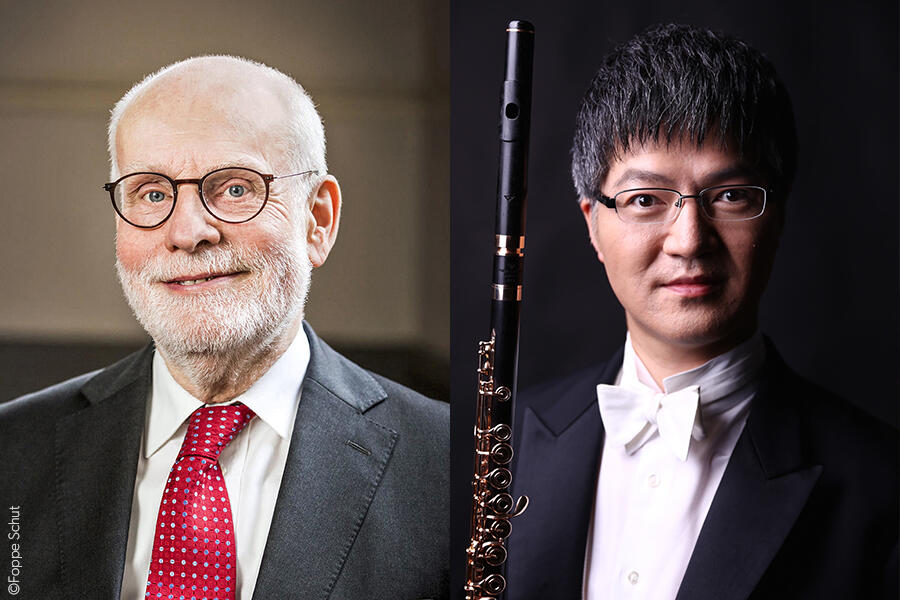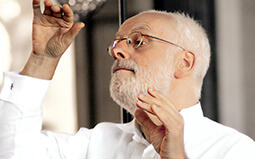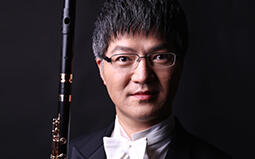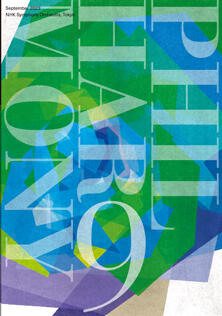- Home
- Concerts
- Subscription Concerts 2023-2024
- Program B
- No. 1991 Subscription (Program B)
Subscription Concerts 2023-2024Program B
No. 1991 Subscription (Program B)
Suntory Hall
Google Map Seating Chart

Program
Mozart / Symphony No. 29 A Major K. 201
Mozart led a short but dense artistic life. He left us around fifty symphonies (including unnumbered ones) written over a quarter century, from No. 1 K. 16 penned in his childhood to No. 41 K. 551 Jupiter. They show us the evolution of his style from its starting point around the influence of Italian sinfonia (predecessor of the Classical symphony) with three fast-slow-fast movements. Of the middle period, No. 29 confirms a marked shift away to Viennese four-movement structure with a minuet movement, along with some contemporaries including No. 25 K. 183 “Little G minor.” The two masterpieces are often thought to anticipate Mozart’s supreme matureness in his last three symphonies (described below).
No. 29 was written by the eighteen-year-old composer in April 1774 in Salzburg, then his home, after his third five-month Italian tour and two-month stay in Vienna. Though the trips’ aim of obtaining a new job was not achieved, it is easy to imagine that the young Mozart absorbed a good deal at the leading centers of music. The distinctive features of No. 29 are the chamber-oriented transparent instrumentation (strings with only pairs of oboes and horns), the more-than-usual number of melodic elements which are sometimes treated in a polyphonic manner, as well as the thematic unification found between the outer movements in sonata form. To be more specific, the octave-dropping motif heads the first themes given at the outset of the opening and closing movements.
[Kumiko Nishi]
Mozart / Flute Concerto No. 2 D Major K. 314
A magnum opus, Mozart’s Flute Concerto No. 2 remains uncertain when and how it was penned. Based on the most common view, it was born during his stay (October 1777 to March 1778) in Mannheim which was then celebrated for its outstanding, cutting-edge court orchestra. Through his friend Johann Baptist Wendling who was a flute player of the orchestra, Mozart received a set of commissions including three flute concertos from a wealthy Dutch amateur flutist. However, the number of concertos the composer rendered to his client was only two. Worse, one of the two – known today as Flute Concerto No. 2 – was a rework of his C-major Oboe Concerto (presumably written in April 1777). According to another view, this Flute Concerto was premiered prior to Mozart’s departure for Mannheim. At any rate, the work sounds as if it was originally written for flute, maximizing the potential and charm of the instrument which was still developing at the time.
Mozart heads the opening movement Allegro “aperto” (literally meaning “open”, “clear”, “frank”): this designation is rare but also found in some of Mozart’s early concertos. After violins introduce the two sonata themes, the flute solo enters in a bright and open manner to keep singing flowingly. The next slow movement fully exhibits the lyrical and melancholic nature of the flute, then the finale unfolds a high-spirited rondo with the recurrent perky theme given by the soloist at the beginning.
[Kumiko Nishi]
Mozart / Symphony No. 39 E-flat Major K. 543
For Mozart, the year 1788 – three years before his death – was a hard one. Following his father’s passing in 1787, his daughter Theresia died prematurely in late-June 1788. It was also from this year that his financial situation in Vienna took a turn for the worse. He since asked his freemason fellow Michael Puchberg for loans repeatedly. Unable to pay rent, Mozart’s family ended up moving to a distant suburb in mid-June. Caught in this predicament, however, Mozart was incredibly prolific. In addition to many other pieces, he completed his last three symphonies in a phenomenally quick succession: No. 39 on June 26, No. 40 “Great G minor” K. 550 on July 25 and No. 41 Jupiter K. 551 on August 10, 1788.
One of the rarities of No. 39 is the presence of clarinets instead of oboes. Among his symphonic output besides No. 39, oboe is absent only in a few symphonies from the early 1770’s. As clarinet was a new instrument, he scored for it (as a pair) solely in late symphonies, namely in No. 31 Paris K. 297, No. 35 Haffner K. 385 and the revised version of No. 40 K. 550, always “with” oboes. His choice (and nonuse) of instruments thus makes the sound of No. 39 uniquely round.
No. 39 is also unique in that the first movement has an introduction and, moreover, it was an exceptionally-long, fairly-dissonant introduction for those days: this magnificent duple-time opening leads seamlessly to the cheerful main Allegro section in triple time. The minuet movement in A–B–A form is particularly known for its central section where two clarinets give a superb duet interjected by a flute. The lively finale in sonata form points toward both Mozart’s senior Haydn and his junior Beethoven with its monothematic approach: as the first theme presented by violins at the beginning is rephrased to be the second theme, this movement seems to seek an elaborate motivic development more than a thematic contrast.
Incidentally, Mozart often chose E-flat major for his freemasonic pieces, the best example of which is his last opera Die Zauberflöte (Magic Flute) (1791).
[Kumiko Nishi]
[Encore]
Sept. 20: Mozart (arranger: unknown) / Die Zauberflöte, opera (The Magic Flute) - Der Vogelfänger bin ich ja (The Birdcatcher's Aria)
Sept. 21: Mozart (arranger: unknown) / Die Zauberflöte, opera (The Magic Flute) - Ein Mädchen oder Weibchen wünscht Papageno sich! (A Girl or a Little Wife)
Hiroaki Kanda, flute
Artists
 ConductorTon Koopman
ConductorTon Koopman
Ton Koopman was born in 1944 in Zwolle, the Netherlands. He studied organ, harpsichord and musicology at the Amsterdam Conservatory, and as an organist and harpsichordist, rose to prominence as an outstanding interpreter of Baroque music, including works of J. S. Bach and Buxtehude. As a conductor, together with the Amsterdam Baroque Orchestra which he established in 1979 (a choir was added in 1992) to perform with period instruments, he has taken up a repertoire ranging from baroque to classical periods to perform works based on the style and playing technique of the time these works were composed, for which he has won high acclaim. He is also known for his extensive discography including Bach’s complete cantatas and organ works. On the other hand, in recent years, he has also been garnering attention for his approach exploiting the idea unique to an early music performer when actively conducting the leading modern orchestras of Europe and the U. S. such as the Berliner Philharmoniker.
He made guest appearances with the NHK Symphony Orchestra in 2017 and 2019, conducting all Mozart programs including Symphonies No. 40, No. 41 Jupiter, and Requiem. In the coming first appearance to conduct the orchestra’s subscription concert (he was scheduled to appear for the orchestra’s subscription concert for the first time in 2021, only to be cancelled due to COVID-19 pandemic), he has chosen an all Mozart program, and we expect to hear a delightful and lively performance typical of him. Collaboration with Hiroaki Kanda, the NHK Symphony Orchestra’s principal flutist, is also what we look forward to.
[Motoyuki Teranishi, music critic]
 FluteHiroaki Kanda (Principal Flute, NHKSO)
FluteHiroaki Kanda (Principal Flute, NHKSO)
Hiroaki Kanda, principal flutist of the NHK Symphony Orchestra, has won 1st prize at the 5th Japan Flute Convention Competition and at the 8th Japan Wind and Percussion Competition in 1991. He graduated from Tokyo University of the Arts in 1993, studied further at the University of Music and Performing Arts Vienna for one year from 1995, and finished Tokyo University of the Arts Graduate School in 2007. Tutors he has studied with to date include Keiichi Akahoshi, Chang-Kook Kim, Junzo Hosokawa, Wolfgang Schultz, and Hans-Georg Schmeiser.
He joined the NHK Symphony Orchestra in 1994, and became its principal flutist in 1999. As a soloist he has made guest appearances with orchestras including the Kyushu Symphony Orchestra and the Sendai Philharmonic Orchestra. He has released a large number of CDs, at the same time, he has also been active in a wide range of fields such as writing music practice books, supervising the revision of scores, and arranging more than 60 titles of flute ensemble.
While serving as a specially appointed director of the Japan Flutists Association and permanent director of the Asia Flutists Federation Japan, he has also been ardently teaching young artists as professor of Toho Gakuen University, a visiting professor at Osaka University of Arts and a lecturer at Tokyo University of the Arts.
Download
Ticket
Program B
No. 1991 Subscription (Program B)
Suntory Hall
Google Map
Seating Chart
Single Tickets Release Date
Pre-sales for Subscribers:Thursday, July 27, 2023
*about subscribers
Sale to General Public:Sunday, July 30, 2023
Price
| S | A | B | C | D | |
|---|---|---|---|---|---|
| Ordinary Ticket | 9,800 | 8,400 | 6,700 | 5,400 | 4,400 |
| Youth Ticket | 4,500 | 4,000 | 3,300 | 2,500 | 1,800 |
Seating chart Enlarge Print PDF
*tax included
*Subscribers receive a 10% discount (Available at NHKSO WEB Ticket and N-Kyo Guide)
*For wheelchair-accessible seats, please refer to the N-Kyo Guide
Youth Tickets
Youth Tickets are great options for those of 25 years old and younger
Subscription tickets
Release Date
ANNUAL SUBSCRIPTION TICKETS
Mon., July 17, 2023 10:00am
[For Subscribers: Sun., July 9, 2023 10:00am]
For further information and
subscription application
*Repertoire, conductor, soloists and program order are subject to change without notice.
*Pre-school children are not allowed in the concert hall


